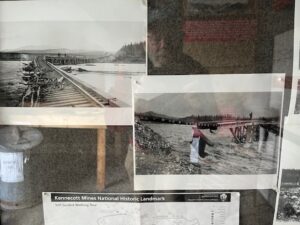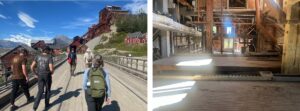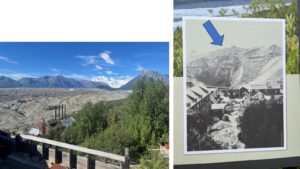Ahhh, a refreshing drink of cold water on a warm late summer day. I’m aware of where the water comes from, but less so the copper pipes in my house through which it courses. It might be that the copper came from the Kennecott Copper Corporation’s mines in the Wrangell Mountains of Alaska – a place I returned from just recently. The mining operation ceased in 1938 and my house was built in 1940. Could it be that every drop of water from my house ties me somehow to Kennecott, AK?
Copper is the subject of this real-life story of the Alaskan wilderness. It is the tale of a nation hungry for copper at the beginning of the 20th century; the industrialist who devised the means to extract, process, and transport it to market; and the workers that labored in mines at dizzying mountain heights with the ever-present shifting glacier below.
In the late 1800s early 1900s during the Industrial Revolution, demand for cooper soared. Copper was needed for wiring to electrify the cities and towns and for automobile and building materials. This was in the days after the Klondike Gold Rush brought many prospectors and fortune-seekers to the Alaskan wilderness. In 1900, two such adventurous prospectors, Clarence Warner and “Tarantula” Jack Smith, found Kennecott’s “Bonanza” deposit of remarkably pure copper ore at 6,000 feet along a jagged ridge line.
Why such pure copper in the Wrangells? These massive mountains (six of the highest peaks on the continent) were pushed up by volcanic and sedimentary rocks migrating north with fragments of the earth’s crust from warm Pacific water to present-day Alaska over 50 million years ago. Chalcocite (the precursor of copper ore) formed at the juncture of the greenstone (metamorphosed basalt) and overlying limestone (derived from ancient coral, sea plants, and creature shells). The chalcocite found on Bonanza ridge was both abundant and remarkably pure compared to anywhere else on earth.
It took mining engineer and industrialist Stephen Birch, with financial backing from the wealthy Havemayer family along with J.P. Morgan and the Guggenheims (collectively known as The Alaska Syndicate), to have the audacity to try to construct the tunnels, trams, and processing facilities to extract the copper ore, and also the dormitories, school, post office, general store, hospital, and other facilities for workers, since there were no such accommodations in the wilderness. One of the chief challenges of the operation was getting the product to the smelter in Tacoma, Washington from the remote Wrangell mountains where there was only primitive transportation infrastructure.
The first four years of the enterprise involved constructing the nearly 200-mile-long Copper River & Northwestern Railway (CR&NW) — its tracks and thirty miles of trestles, and tunnels — to get the ore to the port in Cordova, Alaska, and then to the smelter in Tacoma by steamship. This was no small feat, as the year-round efforts (temperatures could dip to forty below in the winter) involved working through and around high mountains, raging glacier-fed rivers, unstable glaciers and rocky moraines, and bogs. Birch even had a 70-ton Valdez-based steamship disassembled piece-to-piece, caried over the high mountains, and re-assembled in the Copper River as a means to get mining equipment to the site – the arctic version of Werner Herzog’s Fitzcarraldo.

In an astounding example of what we now call “value engineering,” engineers determined that is was more economical to rebuild this rail trestle across the Copper River after it was demolished by the annual ice break-up than replace it with a more permanent steel structure. Source: McCarthy-Kennecott Historical Museum, photo: D. Hirschman.
The mining itself endured from 1911 to 1938, with round-the-clock shifts to extract the ore from the Bonanza and Jumbo mining sites, down the mountain via tram, and into the concentration mill where copper was separated from limestone, sorted, concentrated, and loaded onto railway cars. In the end, $200 million in copper was processed at Kennecott, and the investors plowed the profits into mining operations in the American West and Chile.
Maintaining the workforce was part of the calculus. This was dangerous work. The miners and mill workers were young men from Midwestern farms, lower 48 mining towns, WW I veterans, and plenty of immigrants from places like Sweden, Norway, Italy, and Greece. Others came from Japan to assume laundry and food service positions. They were all looking for opportunity, and the pay and relatively favorable working conditions at Kennecott attracted them. There were also women and children, but only associated with the management class, as the mainline workers were not allowed to bring families along.
The conditions could be austere: no booze, no drugs, only two days off per year – Fourth of July and Christmas. Many workers only stayed a short time, long enough to pay off the train fair to get there in the first place and then to get back home, with hopefully a little extra to spare. It could take a year or more of work to achieve this objective.

St. Elias Alpine Guides lead tours of the historic mill town and the 14-story concentration mill. Inside the mill, although now still and quiet, you can still see some of the machinery and processing equipment used to refine the the copper ore. Photos: D. Hirschman.
Some never made it home. From the old mill town, I walked about a mile “down-moraine” from the Kennecott town site on the old wagon trail, through young spruce, aspen, and poplar forests (with plenty of raspberries in the understory along the way) and arrived at the old Kennecott cemetery.
The weedy site, marked by picket fences in need of both whitewash and repair as well as wooden crosses in similar condition and a few headstones, contains the graves of Kennecott folk that died between 1908 and 1938, including many workers at the copper operation.
The Park Service, with assistance from a group called the Pioneers of Alaska, created signage that includes brief biographies as well as the causes of death for the fifty souls buried in the cemetery. Reading the biographies made each of these people real and palpable. Here is just one example from the fifty:
Oscar Prytz was born 1894 in Sweden. He immigrated to the United States in 1914 and became a naturalized citizen four years later. After being involuntarily enrolled in the U.S. Army in 1919, Prytz requested a job at Kennecott from Superintendent Foster. He was discharged from the infantry on the basis of his contribution to the war effort through employment with the Kennecott Copper Corporation. He died three years later falling from a cliff while hunting. Buried 20 October 1923.
Source: Pioneers of Alaska, National Park Service
Poor Oscar fell from that cliff, but the causes of death listed on the sign revealed the many other sudden and violent ways to die in a such a mining operation in the early 20th century.
- Crushed (by falling timber, large falling rock, utility pole, and train)
- Suffocated (inhaling powder gas, falling into a run of ore and muck)
- Falling (or in some cases jumping) from a cliff or down a mine shaft
- Becoming entangled in a skip chain
- Explosion
- Several suicides and one murder

The old Kennecott Cemetary is about a mile down the wagon road. In this quiet corner, you can contemplate the lives of the miners and also the various ways that they perished performing the dangerous work. The signage is from the National Park Service with research by the Pioneers of Alaska. Photo: D. Hirschman.
Eventually, the “bonanza” of remarkably pure copper ore reached the point where more extraction and processing was no longer profitable for the investors, especially as the Great Depression took hold. The last train out of Kennecott left on November 10, 1938. The last shift-workers at the mill had one hour to pack up their belongings to make the train, or be left behind in the wilderness. People took what possessions they could on that last train, but had to jettison many items of their daily domestic lives in the place they had called home. The Kennecott Copper Corporation also left many tools, parts, and materials, available for scavenging by the few homesteaders remaining in the Wrangells.
Overnight, the place depopulated, in a drama that plays out repeatedly where resource extraction is the basis of a region’s economy and the most obtainable of the raw materials simply play out. King Copper could only rule the Wrangells for so long.
According to Tom Kizzia in his book Cold Mountain Path, if one visited Kennecott in those ghost town years after the last train, you might walk into one of the manager’s cottages. The curtains would still be on the window, billowing in the breeze from a cracked window. The calendar on the wall would still be turned to November, 1938, and the wind’s lonely lament would replace the cacophony of roaring machinery in the fourteen-story now-vacated mill building.
And that is part of the experience you can still have today. The Park Service maintains the Kennecott site as National Historic Landmark. While a tour of the mill and surrounding structures highlights the engineering marvels of the operation (and there were many that defy imagination), the cemetery reveals the cruel underbelly of such an undertaking, and both things co-exist in the tale of such a place.
A modern-day visit to Kennecott, if you can manage the long journey, immerses you in the still-palpable feel of a ghost town, although one that is more managed with the Park Service presence. You can also visit the old town of McCarthy five miles down the Kennecott road. In the mining days, this was the provision and entertainment center — meaning plenty of alcohol, brothels, and other ways for miners to part with their hard-earned cash.
Today, as a town within the vast Wrangell St. Elias National Park and Preserve, McCarthy serves as the jumping off point for history buffs, hiking, backpacking, river rafting, glacier walks, Dall sheep hunting, and many other outdoor activities, as well as an occasional and surprisingly good band at The Golden Saloon or The Potato restaurant. The crowning experience would be a flight seeing trip with Wrangell Mountain Air (you may even get Oren Hirschman as your pilot or Gita Hirschman to assist with your flight logistics) to view the towering mountains, bogs, lakes, unbroken boreal forests, and still-mighty but receding glaciers.

It is quite “chilling” to see how much the Root Glacier below Kennecott has receded and shrunk. During the mining days, the glacier towered above the town, such that you couldn’t even see the high mountains across the valley (right; blue arrow is the top of the glacier, not a distant mountain!). Today, that part of the glacier is covered is rubble from the moraine and has shrunk 300 vertical feet in the past 100-years or so (left). Source: National Park Service information sign at Kennecott. Photos: D. Hirschman.

Viewing the glaciers from the air is spectular, as you can see the icefalls flowing from some of the continent’s highest mountains, the glacial ice, and the lateral and medial moraines. It is rare privilege to be able to view and appreciate some of the Earth’s remaining glaciers. Photo: D. Hirschman.

McCarthy-Kennecott is a recreational mecca. There are several outfitters that can take you on historic mill tours, glacier walks, rafting trips, backcountry trips, and drop-offs for sheep hunters. The photo is from our family adventure crossing the Root Glacier and up the moraine to the Donoho Basin and its lakes, complete with noisy loons! Photos: D. Hirschman & E.G. Mellen.
There is one other story worth telling here and that is about a man named George Flowers.
Flowers built a cabin in the Long Lake area near McCarthy and Kennecott. He worked in small gold mines, ran trap-lines, and worked as a track walker (looking for hazards) along the railroad. Otherwise, he hunted, fished, and gardened (true to his name) for his sustenance. Flowers also played guitar for the visiting “Kennecott kids,” as Long Lake was a kind of summer camp for the Kennecott managers and their families.
The interesting part is how George Flowers got to Alaska in the first place. He started life in a Black sharecropper family in Mississippi, born only a few years after Emancipation. The onset of Jim Crow and the economic depression of the 1890s led him to embark on a long journey, following many others in the Gold Rush days. He hopped freight trains to Seattle, and learned that as a Black man, he was not allowed to purchase a ticket on a steamship to Alaska.
So, he walked – 2,200 miles along telegraph lines and gold rush trails. The emaciated Flowers arrived at a Native Ahtna village and was taken in at a nearby mining camp. From there, he built his homesteader life. In an ironic and cruel twist, a piece of his Deep South roots manifested in far-north Alaska. The Kennecott mine managers would not hire Black men, but authorized the Ku Kluz Klan to hold minstrel shows in the community hall. It was these managers’ children that Flowers entertained with this guitar in the summers at Long Lake.
George Flowers was buried near Valdez, but even his grave was apt to wander, as it washed out to sea during the 1964 Good Friday Earthquake, which destroyed much of that community.
I don’t know if the copper pipes in my house derived from Kennecott copper, but, sparked by the original profits from the Kennecott mines, the company (now Kennecott Utah Copper) remains one of the largest mining companies in the world. Speaking of large, the company’s Utah mine is said to be the largest artificial excavation on the planet.
King Copper once ruled the Wrangells, but the metal’s value appears to be perennial. I read recently that people are stealing EV charging cables to recover the copper. As is so often the case, the king is also a thief (1).
David J. Hirschman, dave@hirschmanwater.com
September 10, 2024
My Alaska-themed post from last year, Dispatches from the Cryosphere, goes into more detail about glaciers and what it’s like to visit them in the era of climate change.
(1) The last sentence of this post could be read with multiple meanings, and here is one. Kennecott historians note that almost all profits from the hugely productive mines flowed to the out-of-state investors. Alaska was left with a ghost town, abandoned machinery and buildings, not to mention a liability of heavy metal contamination. This type of situation is salient for any place with the largely extraction-based economy. However, since Alaska didn’t achieve statehood until 1959, the state was able to enshrine a different path in its state constitution. Based in good measure on the Kennecott experience, the state made sure that other extractive enterprises – chiefly the Trans-Alaska Pipeline – would leave at least part of the generated wealth locally and also compensate the land claims of Native Alaskans.
References & Resources
Tom Kizzia, Cold Mountain Path: The Ghost Town Decades of McCarthy-Kennecott, Alaska, Porphyry Press, 2021. A detailed and enthralling account of the last train out of Kenncott and ghost town years that followed, with a cast of strange and rugged homesteaders.
Barbara ‘Bo’ Jensen, Wrangell-St. Elias National Park & Preserve: The Journey of George Flowers, National Parks Traveler. Thanks for Barbara for teasing out the story of George Flowers from various sources.
National Park Service, U.S. Department of Interior, The Kennecott Story, Kennecott Mines National Historic Landmark, Wrangell-St. Elias National Park & Preserve.
National Park Service, U.S. Department of Interior, For The Love of Freedom: Trappers, Hunting Guides, and Homesteaders: An Ethnographic Overview and Assessment, 2018. This is a comprehensive and detailed description of the people that not only survived in the wilderness but also cultivated community and livelihood.
St. Elias Alpine Guides, Kennecott Mill Town Tour. I had a couple of very informative and interesting tours of the old mill town led by these well-informed guides. I went on this excellent tour twice in the past few trips to the area. Thanks to Ben and Haley for the adept storytelling.
The Epic Story of Alaska’s Copper River Railway, YouTube, 2022. The tenacity of human endeavor never ceases to amaze, and also the sacrafices of the workers who got it done.
